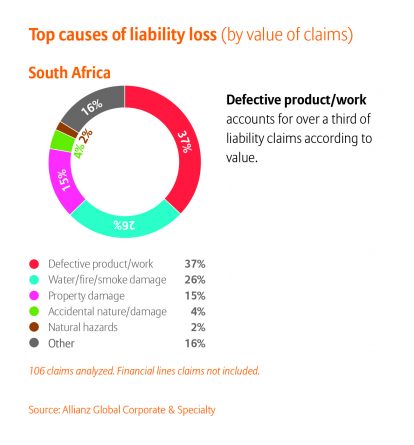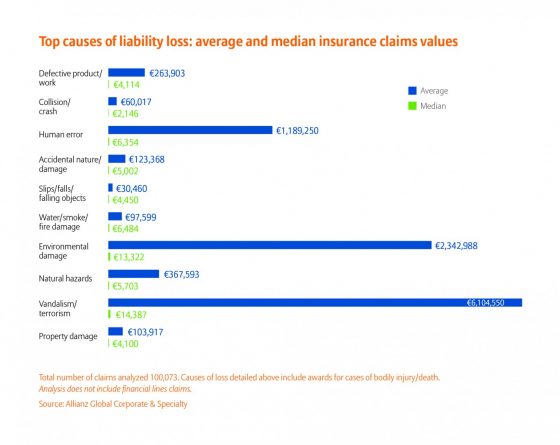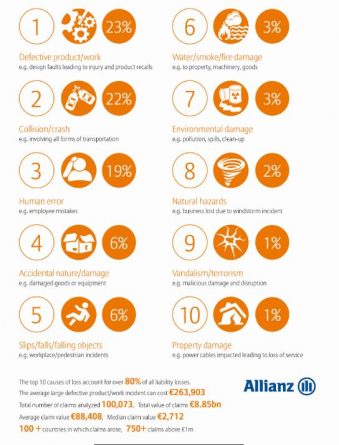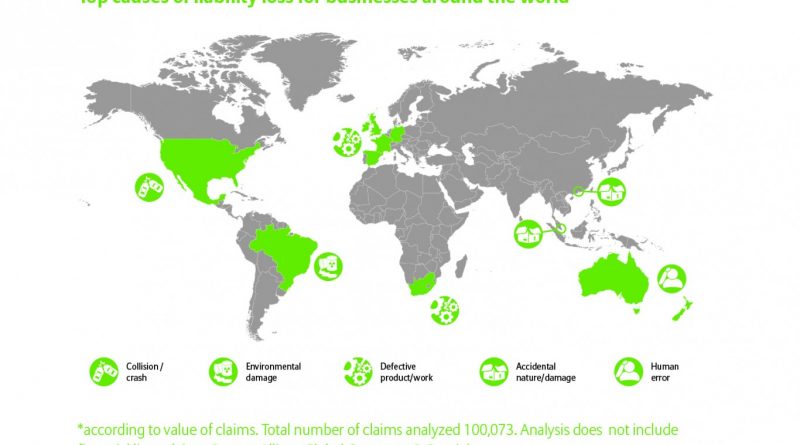Allianz report: Companies face rising liability losses around environmental, cyber, product defect and recall risks
A defective product is recalled around the world. Human error results in a major shipping incident. Credit card data is stolen in a cyber-attack. A dam collapses causing significant damage to the environment: Modern corporate liability exposures can arise from a growing number of sources and have the potential to result in larger and more complex losses for businesses than ever before, warns Allianz Global Corporate & Specialty (AGCS) in a new report Global Claims Review: Liability in Focus. The report identifies defective product or work, crash and human error incidents as the largest causes of liability loss for businesses, based on analysis of insurance claims.
While ‘everyday’ liability claims like slips and falls or workplace incidents have been reducing due to more stringent safety regulations and better risk management, the report says the potential for more expensive liability losses around the world is increasing, particularly in relation to global product recalls, corporate liability, cyber and environmental incidents. Additionally, new corporate liability exposures will arise from disruptive technologies and the more complex business models of the growing ‘sharing economy’.

“Liability losses are and can range from minor and mundane incidents to major disasters, always causing third party damage or injury,” says Alexander Mack, AGCS Board Member and Chief Claims Officer. “The risk landscape for businesses is constantly shifting with liability risks on the rise globally. New technologies such as the internet of things, autonomous mobility or 3D printing will create fundamentally new liability scenarios for companies in almost every sector.”
The AGCS Global Claims Review analyzes over 100,000 corporate liability insurance claims from more than 100 countries, with a total value of €8.85bn (US$9.3bn), paid by AGCS, and other insurers, between 2011 and 2016. Over 80% of losses arise from ten causes.
Top 10 causes of liability loss by total value of claims
1 Defective product/work
2 Collision/crash
3 Human error
4 Accidental nature/damage
5 Slips/falls/falling objects
6 Water/fire/smoke damage
7 Environmental damage
8 Natural hazards
9 Vandalism/terrorism
10 Property damage
Top causes of loss and claims trends
Impact of a defective product or work is the largest cause of loss, accounting for almost a quarter of the value of all claims (23%). The average loss costs businesses in excess of €260,000 with the cost of product recalls being a major driver. “The number of recalls has been steadily rising with increased focus on product and workplace safety, as well as more proactive regulation,” says Larry Crotser, Head of AGCS Chief Claims Office, North America.
Significant improvements in automotive and aviation safety may have reduced the number of collisions and crashes in recent years but these are still a major driver of liability losses, accounting for over a fifth of the value of all claims (22%), as well as generating the most claims. Human error (19%) is the third top cause of loss, driven by incidents which result in major losses, such as aviation and shipping events or employee injury.
Human error is a leading cause of claims in Africa
Africa’s leading cause of liability claims by value is human error at 77%. Defective product/work accounts for 10% of liability claims in value while natural hazards are at 4%. In South Africa, defective work/product leads the way at 37% in terms of top causes of liability loss by value followed by water/fire/smoke damage (26%) and property damage (15%).
“Accidents happen and they are sometimes very difficult to foresee or prevent. This is what insurance is for. However where a process or procedure can be engineered to ensure that that businesses carry out tasks with due care, foreseeable losses could be curbed. Companies have to be aware of the potential losses before they can mitigate them, so we share loss information and potential loss scenarios with our clients to enhance risk management methods,” says Storm Canham AGCS Africa Liability Team Leader.
Larger losses more commonplace
According to the report losses in excess of $1bn are becoming more commonplace and are no longer confined to the US, and Europe, as regulators become tougher, supply chains more complex and US-style litigation and compensation awareness spread around the globe.
The US continues to be the world’s largest liability market generating both the highest number of claims, and many of the largest claims according to value. “However, we do see a trend towards greater liability claims outside the US with rising awareness of consumer rights and compensation in Asia and Europe,” says Peter Oenning, Global Head of Liability Claims, AGCS. While class actions by consumers and investors remain largely a US affair, a growing number of countries now also allow for collective actions. Conversely, foreign companies are increasingly being sued in the US.
Insurers are also seeing a significant increase in large environmental liability loss activity, in the mining and construction sectors, and in Latin America and Asia. Analysis shows the average environmental damage incident costs businesses in excess of €2.3m, although costs will be significantly multiplied in major disasters. 
Technology to drive big shift in liability losses
In future, digitalization and growing use of new technologies are likely to lead to a further shift in the liability risk landscape. Overall, the frequency of claims is expected to decline as trends such as autonomous driving improve road safety. However, technology will also bring new liability threats such as increasing cyber, product liability and recall risk. Automation is likely to lead to increased product liability risk for machinery and component manufacturers and software providers, for example. New data protection laws around misuse or breaches of data will increase cyber liability for companies, potentially resulting in heavy fines and penalties, particularly in Europe from 2018, but also elsewhere.
The growing “sharing economy” also raises new questions. “Just imagine, a road traffic accident featuring an autonomous car share vehicle could involve the vehicle manufacturer, software provider and the fleet operator, as well as third parties involved in the accident. This would make liability harder to apportion and claims more complex to settle,” explains Oenning. Such a future car accident scenario will require claims handlers to understand sensors and algorithms to determine the cause of an accident. With the handling of liability claims becoming more complex and technical, investing in claims expertise and knowledge is increasingly important.
And finally…unusual liability claims
Liability losses also incorporate more unusual events. Almost 2% of claims analysed involve animals. Deer are the most dangerous due to being involved in collisions with vehicles in the US in particular. Bedbugs are an increasing bugbear for insurers, with the number of claims resulting from infestations and bites in hotels having increased over the past five years.

See links below for the full report and additional information:
- Full report
- Loss data analysis
- Drivers behind the liability loss landscape
- Liability claims trends
- When animals attack – Unusual liability claims




